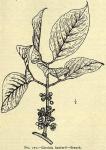 A gum-resin from Garcinia hanbu'rii Hooker filius.
A gum-resin from Garcinia hanbu'rii Hooker filius.
BOTANICAL CHARACTERISTICS.—The gamboge tree has dioecious flowers and a foliage resembling that of laurel. Flowers yellow; male flowers in axillaryclusters, on short, one-flowered pedicels. Female flowers sessile. Fruit a berry, about the size of a large cherry, reddish-brown, containing a sweet pulp.
HABITAT.—Anam, Camboja, Siam, and Cochin-China.
DESCRIPTION OF DRUG.—Lumps, or cylindrical sticks (pipes), 25 to 50 mm. (1 to 2 in.) in diameter, and 100 to 200 mm. (4 to 8 in.) in length, striated lengthwise by impressions from the bamboo in which it is collected. Externally, grayish-brown. It has a smooth, conchoidal fracture of a waxy luster and orange-red in color. The powder is bright yellow and sometimes adheres to the drug, giving it a yellow appearance. Taste at first mild, afterward very acrid; odor irritating, sternutatory. The cake or lump gamboge is sold in masses weighing two or three pounds. It is less uniform, less brittle, and is sometimes called "coarse gamboge." Adulterated specimens are easily recognized by their general inferior appearance, by the grayish or bronze appearance of a broken surface, and by giving a blue or green color with iodine when starch is one of the impurities. Pure gamboge is completely soluble by successive treatment with ether or alcohol and then water.
CONSTITUENTS.—A bright yellow resin (gambogic acid) 73 per cent., soluble in alcohol and ether, turned to a red color by alkalies, and black-brown by ferric chloride; gum 16 to 26 per cent., which, with the resin and hot water, forms a yellow emulsion; wax 4 per cent. and ash not more than 2 per cent.
ACTION AND USES.—A drastic hydragogue cathartic, but so liable to produce vomiting and griping that its action is usually modified by combining it with other milder purgatives. Dose: ½ to 5 gr. (0.0324 to 0.3 Gm.), generally in pill form.
OFFICIAL PREPARATION.
Pilulae Catharticae Compositae Dose: 2 to 5 pills.

